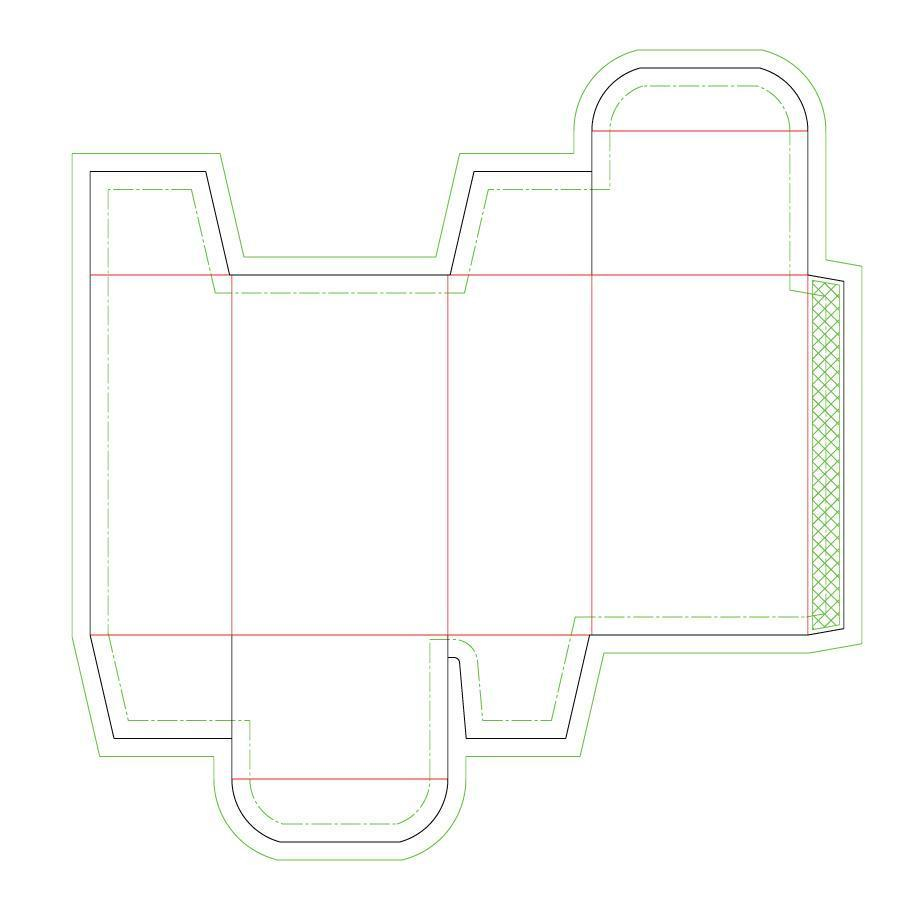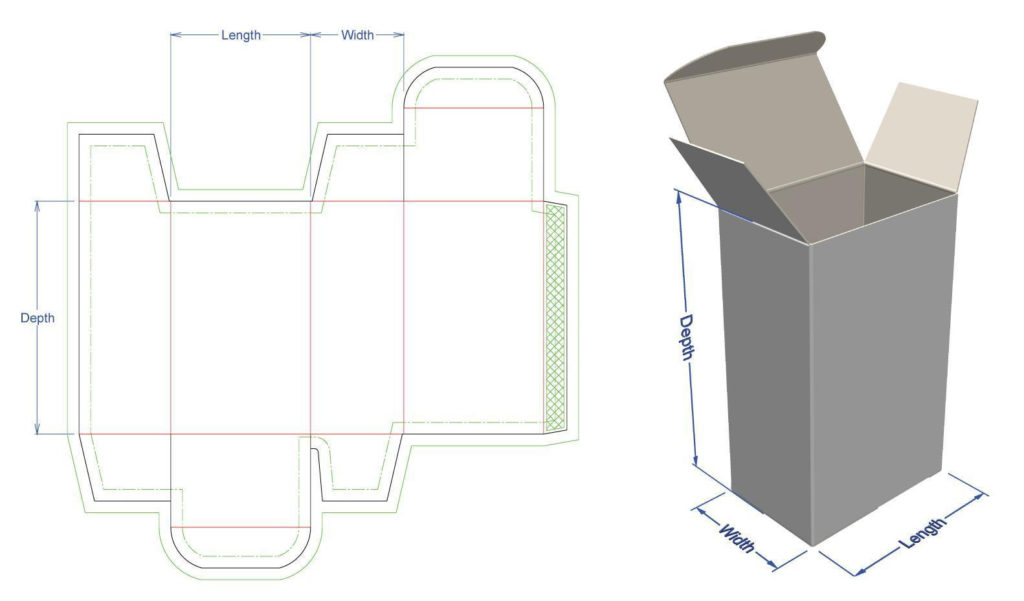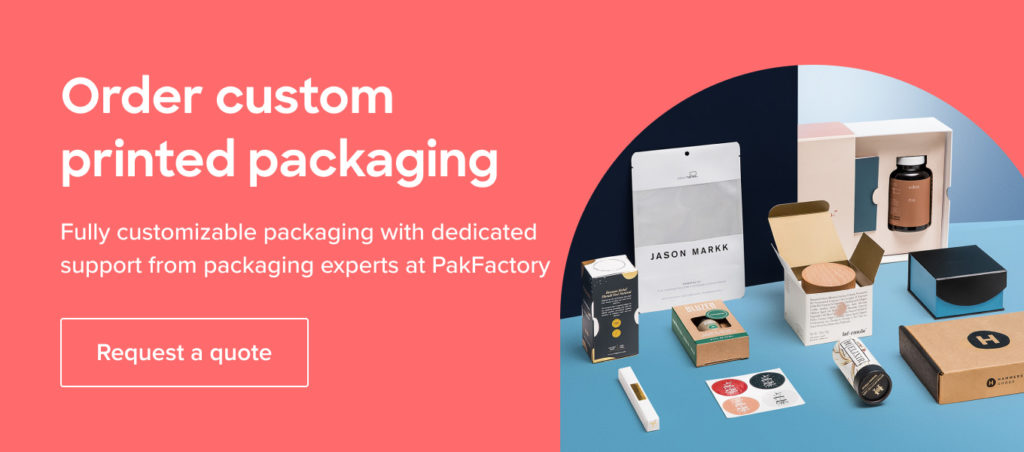Table of Contents
When shopping around and designing your new custom boxes, you will hear the term “dieline” shot around quite a bit!
To the uninitiated, this may seem like a technical term that only a packaging whiz would understand.
But the truth is, it’s pretty simple and crucial to the production of your custom packaging.
Here we aim to lay out everything you need to know about dielines and how to effectively use them in your own custom packaging projects.
Defining Dielines
Dielines play a crucial role in establishing your packaging expectations and standards with designers and manufacturers.
It serves as a blueprint that ensures the correct layout for designs on your packaging.
Dielines highlight all the cut and fold lines of the package in its flattened form and help designers visualize and format art work designs to fit your exact packaging.
Looking at dielines, you’re able to envision how and where your artwork will be displayed.
Dielines make this easier as you’re able to see all sides through the flat construction of your box.Think of it this way; your dieline is your canvas!
Dielines highlight the cutlines, fold lines, crease lines, bleed lines and safety zones to guide die-cutting machines and printers where to cut, fold and print on your packaging.

Fold lines – Marked in red, the fold lines indicate where your packaging will be folded to construct your box. They leave no room for confusion in the construction of your packaging and ensure accurate results.
Cut lines – Shown as black lines and act as a map for the die-cutting machine.
Bleed lines- Marked as a solid green line, bleed lines map the excess space to account for any movement of the substrate during printing and avoids imperfect edges of your artwork design.
Safety lines – Shown as green dotted lines, safety lines indicate the margin that ensures all important artwork will not be cut off during the trimming process.
Glue tabs – represented as green criss cross tabs, glue tabs indicate where adhesive should be applied in the construction of your packaging.
The Importance of Dielines
Dielines are the first glimpse you get of your final packaging design.
It provides the main template for the artwork design and plays a vital role in the die-cutting process and construction of any packaging.
Think of it as a blueprint that ensures accuracy in all physical elements of the final printed product, including:
- Packaging dimensions
- Placement of printed logos, images, and text
- Cutlines
- Bleed lines
- Fold lines
- Creases
- Glue tabs
- Other connection points.
Following the creation of dielines, you will have a pretty good idea of how the end package will look when it’s all put together.
Dielines are regularly used in the production of any packaging including food packaging, beverage packaging, brochures, or any product that requires custom packaging really.
Having a good idea of what your packaging will look like before the die-cutting process gives you a restful mind knowing the placement, colors, measurements and designs are all in the right place.
Furthermore, proofing your dieline allows you to spot any errors in the design, type or even measurements as the flat laying blueprint provides an overall view of your design.
While dielines may seem like a quick and easy way to start your custom packaging project, dielines are actually much more complicated than they look.
A lot of thought is put into the dimensions, placement and designs for your dieline to ultimately create your desired box.
There will be lots of back and forth in terms of editing and repositioning of artwork before you move onto the die-cutting process.
It is extremely important to go through all the proofing stages of your dielines before moving onto the die-cutting process to ensure accurate results.
Note: you can also request prototypes of your finished package to do a final proof of your structure and design before moving onto mass production.

How to Create a Dieline
If you are working with a packaging designer or manufacturer, you likely won’t have to worry about how the dieline is created, that is the designer’s job.
The use of computer software design tools such as Adobe Illustrator or ArtiosCAD, is usually required to create a dieline.
No tool is entirely superior to the other, and choosing one is often a matter of personal preference.
The best way to ensure deadlines are accurate to your custom packaging vision is to provide packaging designers with existing packaging designs or boxes that are closest to what you have in mind.
This way you offer the designer a good starting point that you both can continue to modify until the final packaging is agreed upon.
It is most likely that a manufacturer will provide you with a finalized dieline featuring bleed requirements and notes.
This is the easiest way to create a dieline as all you have left to do is to position your artwork designs on the dieline itself and ensure the colors are matched accurately.
Dieline Requirements
- Dielines must be developed as vector art on computers as computers require mathematically described lines.
- Careful attention is required when inputting specifications while building a dieline.
- You may also want to create a hard copy prototype of the dieline before finalization. This stage is primarily for catching errors before final production.
Exploring the Die-Cutting Process
Die-cutting machines cut out your packaging using a die.
A die is a specialized tool used in manufacturing industries to cut or shape material mostly using a press.
Like molds, dies are generally customized to the item they are used to create.
To properly use a die-machine, you must first create a set of dies that match the desired shapes of your flattened, unassembled dielines.
Dies are thin metal shapes with a raised outline on one side, which cuts through your chosen packaging material.
After creating a dieline for your package, a die-cutting machine will put pressure on a die using rollers and cutting plates to push through the package’s material and create a precise shape and size for your packaging.
Your dielines create a precise guideline for the die cutting machine to create and manufacture your exact packaging design through the die-cutting process.
Note: Your dielines are printed onto large sheets and the die cutting machine precisely cuts the material on a mass scale.
As you can see, dielines play a crucial role in the final look of your packaging. So, it’s important to understand what dielines are and how they are created.
Not a designer or manufacturer? No worries! PakFactory offers full spectrum services for all your custom packaging needs including, design, structural engineering and much more.






